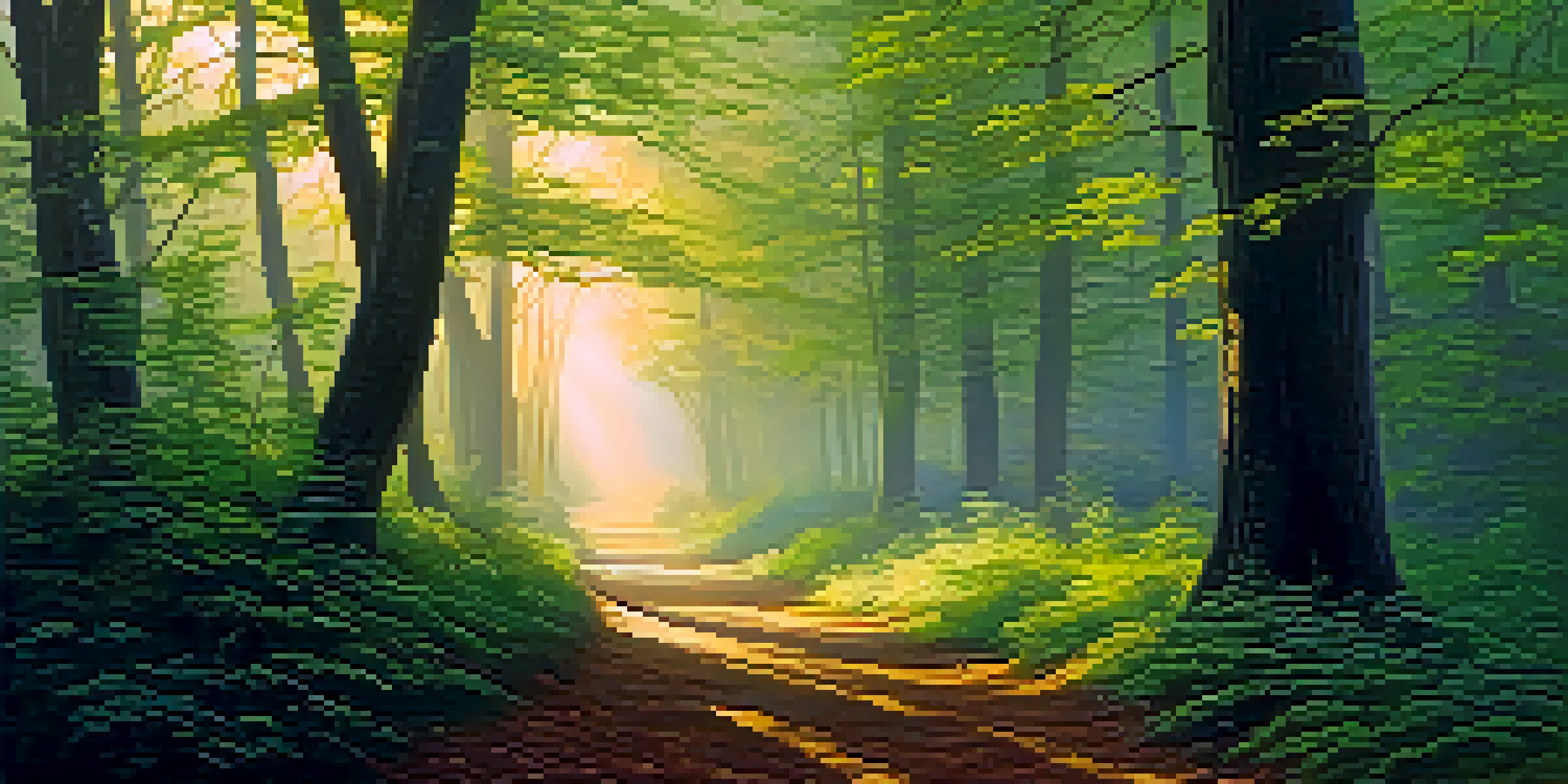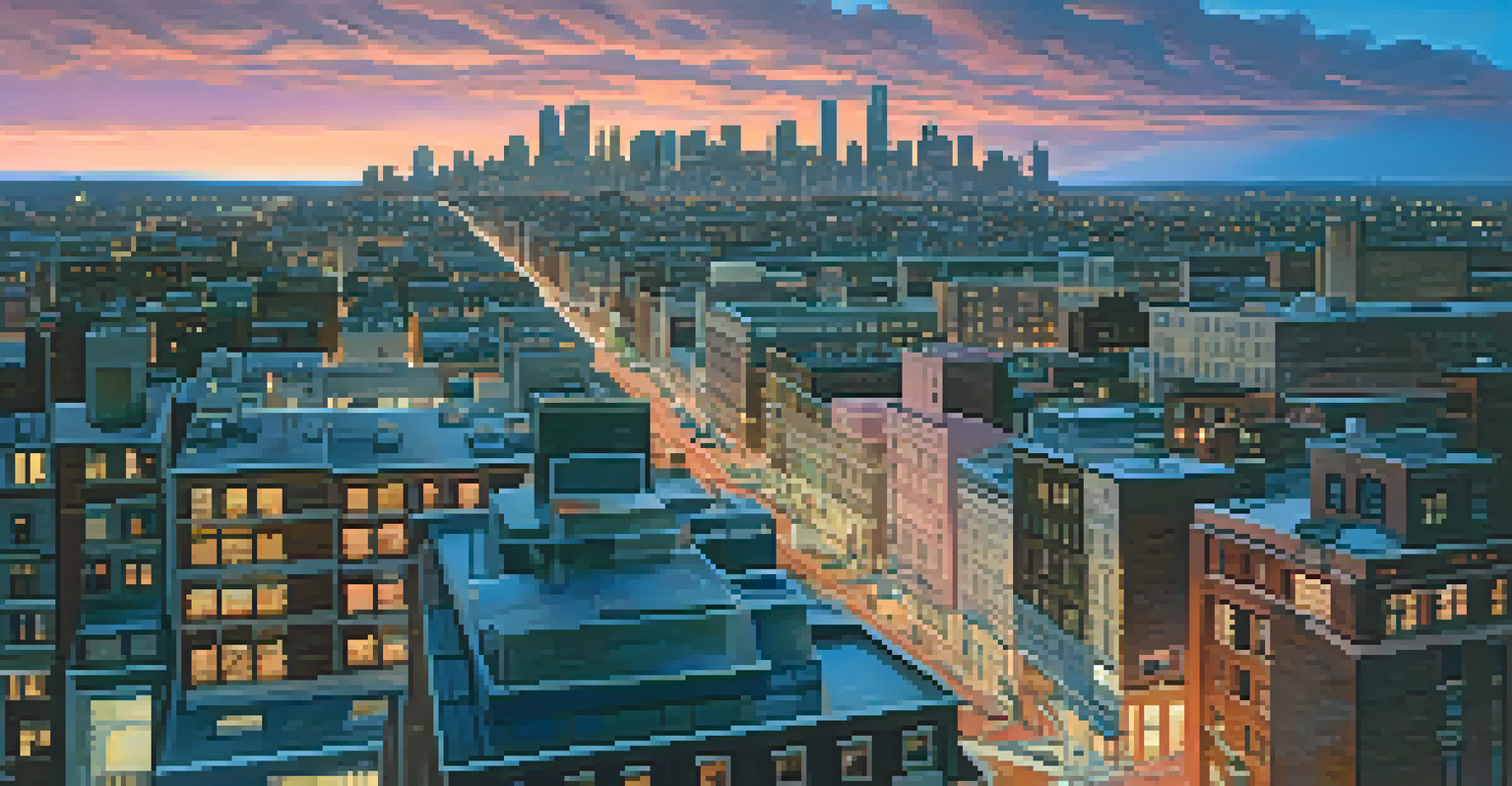Cinematography Styles: Influencing Audience Emotional Response

Understanding Cinematography and Its Impact
Cinematography is the art of visual storytelling in film, using techniques like lighting, camera angles, and shot composition. These elements combine to create a visual narrative that enhances the emotional depth of a scene. By carefully manipulating these techniques, filmmakers can evoke specific feelings, guiding the audience's emotional journey.
Cinematography is infinite in its possibilities... much more so than music or language.
For instance, a close-up shot can draw viewers into a character's emotional state, making them feel connected to their experience. On the other hand, wide shots can create a sense of isolation or grandeur, influencing how we perceive the story's stakes. Understanding these basics helps us appreciate the nuanced ways cinematography shapes our reactions.
Ultimately, cinematography serves as a bridge between the story and the audience, making it essential for filmmakers to master these techniques. By doing so, they can ensure that every scene resonates deeply, leaving a lasting impression on viewers.
The Role of Lighting in Cinematic Emotion
Lighting is a crucial aspect of cinematography that significantly influences mood and emotion. Different lighting styles—like high key, low key, or natural light—set the tone for a scene and affect how viewers perceive the story. For example, low-key lighting often creates a sense of mystery or tension, while high key lighting tends to evoke cheerfulness.

Consider the classic film 'Blade Runner,' where the use of neon lights and shadows establishes a dystopian atmosphere that resonates with feelings of despair and confusion. In contrast, a romantic comedy might employ bright, soft lighting to evoke warmth and joy. This strategic use of lighting allows filmmakers to manipulate the audience’s emotional response effectively.
Cinematography Enhances Emotion
Cinematography combines techniques like lighting, camera angles, and color grading to create a visual narrative that deeply influences audience emotions.
By understanding the importance of lighting, filmmakers can craft scenes that not only look beautiful but also stir specific emotions. This mastery allows them to engage audiences on a deeper level, ensuring that the visual elements of a film align with its narrative intent.
Color Grading: Evoking Emotion Through Hues
Color grading is the process of altering and enhancing the color of a film to convey a specific mood or emotion. Different colors can evoke different feelings; for instance, warm colors like red and orange often evoke passion and excitement, while cool colors like blue and green can create a sense of calm or sadness. This technique lets filmmakers subtly influence how audiences feel about a scene.
The eye should see a film, not hear it. A film should be a visual experience.
Take a movie like 'Amélie,' where the vibrant greens and reds create a whimsical, dreamy atmosphere, inviting viewers to feel joy and nostalgia. Conversely, films like 'Schindler's List' use desaturated colors to reflect the bleakness of the story, emphasizing themes of loss and despair. This thoughtful color application allows for a deeper emotional connection with the audience.
In essence, color grading is a powerful tool in a filmmaker's arsenal, providing a visual language that speaks directly to the viewer's emotions. By mastering this technique, filmmakers can enhance their storytelling, ensuring that every frame resonates with the audience.
Camera Angles: Shaping Perspective and Emotion
The choice of camera angle can profoundly impact how viewers interpret a scene's emotional context. For example, a low-angle shot can make a character appear powerful or intimidating, while a high-angle shot might evoke feelings of vulnerability or helplessness. These subtle shifts in perspective guide the audience's emotional response and influence their connection to the characters.
In films like 'The Godfather,' low-angle shots of Marlon Brando's character create a sense of authority and control, reinforcing his status within the story. Conversely, scenes featuring characters in high-angle shots can evoke sympathy, as they appear small and oppressed. This strategic use of angles allows filmmakers to manipulate the emotional landscape of their narratives.
Lighting Shapes Mood and Tone
Different lighting styles set the emotional tone of a scene, with low-key lighting creating tension and high key lighting evoking cheerfulness.
Ultimately, the camera angle acts as a storyteller in its own right, framing how the audience perceives the emotional weight of a scene. By thoughtfully choosing angles, filmmakers can enhance the emotional impact of their stories, making each moment resonate more deeply.
The Power of Movement: Dynamic Shots and Emotion
Camera movement, whether it's a pan, tilt, or tracking shot, plays a significant role in conveying emotion and enhancing storytelling. Dynamic shots can create a sense of urgency or excitement, while static shots often evoke stillness and contemplation. This interplay between movement and emotion allows filmmakers to engage audiences on various levels.
Consider how an intense chase scene might use rapid camera movements to heighten thrill and adrenaline, making viewers feel as if they’re part of the action. On the other hand, a slow, steady shot during a poignant moment can invite reflection, encouraging audiences to absorb the emotional weight of what they’re witnessing. This balance of movement contributes to the overall emotional architecture of a film.
By understanding the emotional implications of camera movement, filmmakers can craft visuals that resonate deeply with their audience. This technique not only enhances the storytelling but also ensures that viewers remain emotionally invested in the narrative.
Editing: The Rhythm of Emotional Storytelling
Editing is often considered the invisible art of filmmaking, but its impact on emotional response is profound. The rhythm and pace of cuts can dramatically influence how a scene is perceived; quick cuts can create tension and excitement, while longer takes can evoke contemplation and sadness. This interplay between editing and emotion shapes the viewer’s experience and connection to the story.
For instance, in a thriller, rapid editing during a climax generates a sense of urgency and panic, pulling viewers to the edge of their seats. Conversely, in a dramatic film, a slow-paced edit can allow audiences to fully absorb a character's emotional turmoil. This careful orchestration of editing techniques ensures that the emotional journey is engaging and immersive.
Editing Controls Emotional Rhythm
The rhythm and pace of editing significantly impact how a scene is perceived, with quick cuts generating excitement and longer takes promoting reflection.
Ultimately, editing serves as a vital component in the storytelling process, orchestrating the emotional highs and lows of a film. By mastering this craft, filmmakers can create a captivating emotional experience that resonates long after the credits roll.
Symbolism in Cinematography: Visual Metaphors
Symbolism in cinematography involves using visual elements to convey deeper meanings, often evoking emotional responses in viewers. Filmmakers can use specific colors, objects, or visual motifs to represent themes or emotions, enriching the narrative without relying solely on dialogue. This layer of depth encourages viewers to engage with the film on an intellectual and emotional level.
For example, in 'The Shape of Water,' the use of water as a recurring motif symbolizes connection and transformation, heightening the emotional stakes of the story. Similarly, the color red in many films can symbolize passion, danger, or love, subtly guiding the audience’s feelings throughout the narrative. These symbolic choices create a richer viewing experience, inviting deeper reflection.

By incorporating symbolism within cinematography, filmmakers can craft narratives that resonate on multiple levels, encouraging viewers to interpret and connect with the story personally. This technique not only enhances emotional response but also elevates the overall cinematic experience.